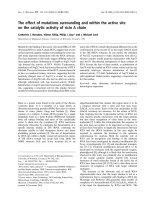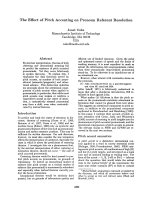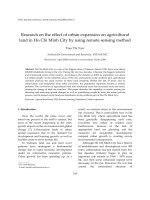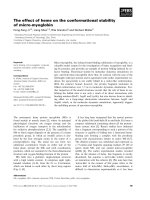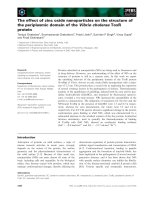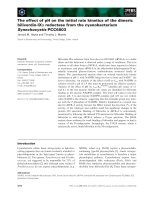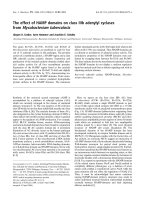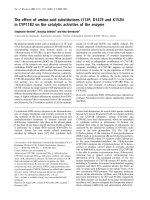Báo cáo " Research on the effect of urban expansion on agricultural land in Ho Chi Minh City by using remote sensing method " ppt
Bạn đang xem bản rút gọn của tài liệu. Xem và tải ngay bản đầy đủ của tài liệu tại đây (314.41 KB, 8 trang )
VNUJournalofScience,EarthSciences24(2008)104‐111
104
Researchontheeffectofurbanexpansiononagricultural
landinHoChiMinhCitybyusingremotesensingmethod
TranThiVan*
InstituteforEnvironmentandResources,VNU‐HCMC
Received11April2008;receivedinrevisedform13July2008
Abstract.HoChiMinhCityisaoneofthebiggestcitiesofVietnam.Before1945,therewereabout
400,000inhabitantslivinginthecity.Duringthelasttwodecades,itbecamethe biggestindustrial
andcommercialcenterofthe
country.Accordingtothestatisticsin2005,itspopulationwasabout
6.2millionpeople. In thesuburbanareas ofthecity, particularly in the northern part, agricultural
activities produce the main income of these local residents. Within the last 15 years, due to
urbanization and emigration from other provinces, the
population explosion became a serious
problem. The conversion of agricultural land into residential areas has increased more and more,
causingthechangeofland‐usestructure.Thispaperdescribesthecapabilityofremotesensingfor
detecting and analyzing spatial changes as well as quantifying results to show the urban growth
process,
anditsimpactontheland‐usedistributioninthenorthernpartofHoChiMinhCity.
Keywords:Agriculturalland;GIS;Remotesensing;Suburban;Urbanexpansion.
1.Introduction
*
Over the world, the cities cover only
about one percent of the earth’s surface, but
most of the issues happening in the cities
greatlyimpactontheenvironmentandglobal
change [7]. Urbanization leads to urban
spatial expansion due to the demand for
developmentand housing growth, as well as
facilitiesareastoservehumanlife.
In Vietnam, land use and land cover
patterns have undergone a fundamental
change due to rapid economic development
under its reformative economic policies.
Urban growth has been speeding up; as a
_______
*Tel.:84‐8‐8651132.
E‐mail:
result, an extreme stress to the environment
has occurred. This is particularly true in Ho
Chi Minh City where agricultural land has
been gradually disappearing each year,
converted into urban or related uses.
Furthermore, because of the lack of
appropriate land use planning and the
measures for sustainable development,
rampant urban
growth is creating severe
environmentalconsequences.
AlthoughHoChiMinhCityhasa history
of establishment and development over 300
years, urbanization has just started from few
last decades. Industry began to play an
important role merely in 1960 – 1970 years
[6], and then some urbanized regions were
obviously
on the rise. However, the war had
caused the constrained situation of
TranThiVan/VNUJournalofScience,EarthSciences24(2008)104‐111
105
urbanization with the great concentration of
huge population, while the industry slowly
developed and living standard was still low.
Fromtheendofthe1980s,HoChiMinhCity
has really entered into the period of
urbanization and was speeded up by
industrializationwithfairlystrongprog ress[6].
Agriculture and rural
areas belong to
general socio‐economic structure of Ho Chi
Minh City with their advantages of
geographical location exist as a suburban of
thebigscientific,technological,industrialand
commercial city. The city has taken full
advantages of location, exploited strength of
industry, service, science and technology to
serve the
development of agriculture and
rural areas. In recent years, due to the
requirements of city expansion, a part of
suburban agricultural land was urbanized.
According to developing strategy for a
civilized, modern and environmental
sustainable city, suburban agriculture has
intended to transform into ecological and
high‐techagriculture.
If the urban
and urbanization issues had
beenstudiedforalongtimeintheworldand
then still have been continued to study, in
Vietnam this problem merely is on research
focus from the middle of 90s [2]. The
monitoring of temporal and spatial changing
issues in urban is usefull for managers
and
planners to draw up a strategy for urban
suitable development. Traditional methods
requiring extensive labour do not bring the
effectiveness in the regional scale because of
high cost of field measurements. Remote
sensing and geographic information systems
(GIS) has been widely applied and has been
recognizedasapowerfuland
effectivetoolin
detecting urban land use and land cover
change[4].GIStechnologyprovidesaflexible
environment for entering, analyzing and
displaying digital data from various sources.
It is necessary to identify urban features for
change detection and database development.
Remote sensing technology can acquire on
the ground objects
without touching them.
Satellite remote sensing collects multi‐
spectral, multi‐resolution and multi‐temporal
data and turns them into valuable
information for understanding and
monitoring urban land processes and for
building urban land cover datasets [8].
Especially, it is useful to consider the
historicaldevelopmentofaregion.Thisstudy
uses
theLandsat TMandETM
+
toextractthe
built‐up land in the city and evaluate the
change of agricultural land under
urbanizationinHoChiMinhCity.
2.Thestudyarea
Ho Chi Minh City has a very favorable
geographicallocationinthecentreoftherich
Southern region with many resources. The
city
has the common administrative
boundary with Long An, Tay Ninh, Binh
Duong, Dong Nai, and Ba Ria – Vung Tau
provinces. Its natural surface area is about
209,502ha, among them 45% is the
agricultural land. The land of the city is
formed by old and recent alluvions, having
poor fertility of
soil, not suitable for
developmentofannualcropproduction[5].
For historical conditions, Ho Chi Minh
Citywasformerlyakindofmonocentriccity.
Before 1975, activities of economy, finance,
culture, education, commerce were mainly
concentrated in District 1, 3 and a part of
District 5. Ho Chi Minh City
has the fairly
rapid speed of urbanization. According to
statistics, the population density has
increased from 552 people/km
2
in 1985 to
2,601 people/km
2
in 2002 (in urban areas
about10,076people/km
2
,in ruralareasabout
602people/km
2
).Non‐agriculturalpopulation
ratehassignificantlyincreasedfrom83.3%in
TranThiVan/VNUJournalofScience,EarthSciences24(2008)104‐111
106
1985to95.2%in2002.Thepopulationgrowth
causing population overload in the city has
been shown not only by the natural increase
on the spot, but also by the mechanical
movementfromotherprovinces.
Asaresult,thereisanindispensableneed
to improve, expand and develop the old
urban
areas in this situation. In addition, the
city sometimes has not controlled unplanned
constructions and urban encroaching
expansion on suburban agricultural land in
thenorthernpart.Therefore,thestudyareais
focused on this part. This is a region with a
lot of advantageous conditions for
developing infrastructure for residential,
commercial and industrial areas. Here is the
place where the urbanization process is
happening fairly strong in the recent years
(Fig.1).
Fig.1.Thestudyarea.
3.Methodology
Thisstudywas basedonremotelysensed
data(satelliteimages),alongwithfieldscheck
and existing maps. Land cover patterns for
1989 and 2002 were mapped by using
LandsatTMandETMdata(Dates:16January
1989 and 13 February 2002). Five types of
land cover are identified and
used in this
study, including: urban, agricultural land,
bareland,shrub/grasslandandwater.
As the first step, the data pre‐processing
was initiated for two images. The images
weregeometricallyrectifiedandregisteredto
the same map projection to lay them over
each other for change detection. The image
registrationwascarefullycarriedoutwiththe
RMS errors less than 0.3 pixel to guarantee
the two coincident images. Due to lack of
atmospheric measures during image
acquisition, the atmospheric correction was
ignored. However, these images were
acquired in dry season (in January and
February)inthestudyarea,sothey
appeared
very clear and cloud free. In this context, the
atmosphericeffectson theseimageswerenot
significant.
Inorderto obtain a high accuracyforthe
interpretationresults,weselectedthetraining
samplesfor each groupofspecific object. For
eachgroup(e.g.water)sometypesofsample
were
selectedbythespectralsignaturesinthe
images (e.g. water 1, water 2, etc.). The
Maximum Likelihood Classification was
carried out for each image. After testing
severaltimestocarryingouttheclassification
as well as adding samples for achieving
higher accuracy, the final results were
accepted. Further activity is the
post‐
classificationtogroupthefragmentaryresults
in five main types of land cover as initial
determination. The confusion matrix was
calculated for the study area after masking
theunnecessaryoutside.Theoverallaccuracy
wasabout88% for the yearof1989,and 86%
for 2002. Then, for analyzing the
nature, rate
Studyarea
TranThiVan/VNUJournalofScience,EarthSciences24(2008)104‐111
107
andlocationofurbanexpansionincompared
with loss of agricultural land; an image of
urban‐residential area was extracted from
eachoriginallandcoverimage.
The urban expansion image was further
overlaid with some geographic reference
images to analyze the patterns of urban
expansion, including image of district
boundary,major
roads.
4.Resultsanddiscusions
4.1.Urbanexpansionduringtheperiodof1989‐2002
The research results showed that
population explosion was the main cause of
urban expansion. Ho Chi Minh City is the
biggest industrial and commercial center of
Vietnam.Thehigheconomicgrowthand
abundant employment opportunities
caused
influx of labor immigration. According to
general demographic investigation to 1st
April 2004, Ho Chi Minh City had 1.8
millionsimmigrantsinthepopulationtotalof
6.11 millions. Local increase of population
plus immigrants made the city become too
stuffy. According to statistics, the urban
populationhasincreased2times
from1990to
2005. The population density in urban
districts in 2005 was reported around 10,608
people per square kilometers [1]. Due to
housing demand and city development,
agriculture land was transformed into land
for houses, roads, industrial and commercial
areas.
From the source of the Department of
Natural Resources
and Environment, the
mainlandusestructureinHoChiMinhCity
isshowninTable1andFig.2.
Table1.MainlandusestructureinHoChiMinhCityoveryears
Landuse/Year 1995(ha) 2000(ha) 2005(ha) 1995(%) 2000(%) 2005(%)
Total 209,376.00 209,502.00 209,554.00 100 100 100
Built‐upland 31,196.34 38,571.07 50,523.72 14.90 18.41 24.11
Agriculturalland 100,366.37 97,247.78 89,659.21 47.94 46.42 42.79
Forest 34,657.58 33,472.15 33,857.86 16.55 15.98 16.16
Water 34,153.02 34,011.29 33,250.02 16.31 16.23 15.87
Unusedland 9,002.96 6,199.54 2,263.67 4.30 2.96 1.08
Fig.2.Thechangesbetweenbuilt‐uplandandagriculturallandfrom1995to2005bystatistics.
0
2
4
6
8
10
12
Built-up land
A
gricultural
land
Forest Wate
r
Unused land
1995 2000 2005
Area (ha)
TranThiVan/VNUJournalofScience,EarthSciences24(2008)104‐111
108
Over the whole city, the land
transformation was realized mainly in the
northern part of the city as shown by the
results from remote sensing data. Fig. 3
shows that the dense settlement presented a
rapid expansion and concentrated in urban
districts and along the main roads in the
suburban areas,
where the agricultural land
yielded to property development Although
built‐up areas have increased in all
directions, it was mainly concentrated in the
North, West and East of the city and along
themainroads.
Result of Landsat image interpretation
shows that during 13 years, from 1989 to
2002, agricultural land
was decreased by
39,329 ha, among which 6,045 ha were
changedto urbanresidental land,and23,065
ha appeared as bare land since the local
farmers sold their lands. They will be used
forfuturebuilt‐uppurposes(seeTable2).
19892002
Fig.3.ResultsofurbanexpansioninthenorthernpartofHoChiMinhCity
in1989and2002fromremotelysenseddata.
Table2.Landusetransformationfrom1989to2002inthenorthernpartofHoChiMinhCity(ha)
Urban
Agricultural
Land
Water Bareland
Shrub/grass
land
Rowtotal
(2002)
Classtotal
Urban 5,150.88 6,045.48 687.96 84.15 892.26 12,860.73 12,860.73
Agriculturalland 393.93 52,577.37 2,200.86 1,550.52 17,276.22 73,998.90 74,060.10
Water 98.82 1,556.01 5,297.04 18.99 982.62 7,953.48 7,963.02
Bareland 851.76 23,065.65 351.45 1,120.59 3,378.15 28,767.60 28,767.78
Shrub/grassland 81.63 8,661.87 310.23 69.30 9,584.10 18,707.13 18,731.16
Classtotal(1989) 6,577.02 91,906.38 8,847.54 2,843.55 32,113.35
Classchanges 1,426.14 39,329.01 3,550.50 1,722.96
22,529.25
Imagedifference 6,283.71 (17,846.28) (884.52) 25,924.23 (13,382.19)
TranThiVan/VNUJournalofScience,EarthSciences24(2008)104‐111
109
By history, due to intensive urbanization
in the suburban districts, such as Tan Binh,
GoVap,BinhThanhandDistrict8,residental
land becomes more and more cramped.
Under the force of circumstances, some
suburban areas were changed into five new
urban districts from 1997. Districts 2, 9 and
Thu Duc
have been divided from Thu Duc
suburban district; District 7 from a part of
Nha Be and District 12 from a part of Hoc
Mon.Besidethat,thedevelopmentofthenew
urban areas such as Nam Sai Gon helped to
extendHoChiMinhCityinalldirections.
As
it is shown by the analysis of remote
sensing data in 1989 and 2002, the built‐up
landincreased most indistrictsTan Binh, Go
Vap, Binh Thanh and District 8, where the
populationisdenselylocated(seeTable3).
Table3.Built‐uplandincreasewithpopulation
District Increased
area in
built‐up
land(km
2
)
Increased
population
total
Increased
population
perkm
2
TanBinh20.34 324,904 14,517.61
GoVap13.49 205,656 10,418.24
BinhThanh11.07 83,864 4,039.69
District88.25 88,423 4,610.17
The change of agricultural land has
happened in the areas with available
infrastructure, near main roads, in the
gateway areas of the city, especially in the
areas planned for residential, industrial,
commercialzones.
4.2.Effectoflossofagriculturallandduetourban
expansion
Agricultural activities in suburban areas
belongto
generalsocio‐economicstructureof
Ho Chi Minh City. From the Day of
Liberation in 1975, agricultural fields as the
city’s green belt have been changed on
generaldemandofcitydevelopmentthrough
different stages with mission of supplying
fresh foods and a part of raw materials for
industrial processing.
Nowadays, rural areas
have been charged with production of high‐
economic‐value agricultural goods,
accommodated market and export. In recent
years, due to the needs of expansion of the
city, a part of suburban agricultural land has
been urbanized. Suburban agriculture has a
tendency to transform into ecological and
high‐tech
agriculture, according to
developing strategy of a civilized, modern
andenvironmentalsustainablecity.
However, due to uncontrollably rapid
urban expansion in the year’s 1990, loss of
agricultural land in rural areas has made a
change of the unplanned city. Agricultural
landinHoChiMinhCity is not only limited
in the size but also is poor on quality due to
the alum‐salted effect plus unfavourable
conditionsontopographyandwater.Thishas
influenced land exploitation potential on
goods orientation. As consequence, the
effectiveness of agricultural land use in
suburban areas has a lower level in
comparisontothewhole
country.Inaddition,
the average norm of agricultural land
distributionforeachhouseholdwasverylow:
0.32 ha per household, just equal 2/3 of the
average norm of the South‐East Region and
equal1/3 ofthe MekongDelta.Thissituation
isapressureonsuburbanfarmersinkeeping
agricultural
production[6].
AccordingtotheinvestigationofInstitute
of Economic Research in June 1996, the
number of farmers owned the crop land was
decreased by 23% compared with the total
landin urbanizedareas[6]. Due tothe above
limitations, plus the impacts of urbanization,
these farmers would not hesitate to
sell land
in order to make capital for another type of
investment. They hoped for higher profits or
TranThiVan/VNUJournalofScience,EarthSciences24(2008)104‐111
110
improvementtheirlifeintheshortterm.Asa
result, this circumstance caused the rapid
reduction of agricultural land. Most of the
yieldedlandhasbeenchangedintotheurban
uses. A lot of new urban areas has rose for
satisfaction of housing demand from
population explosion. This made the city
facing problems of ecological unbalance and
loss of traditional agricultural villages.
Typically, Go Vap floricultural village was
disappeared, now a few points of decorative
plant trade exist as the reminder of this
tradition.Lowlandareas cultivatingwet rice
(such as in District 2) naturally were places
for balance of
the drainage, but constructing
and concretization process made flow to
convergentnarrowsewerages;orthealtitude
raise of new urban areas caused
concentration of water flow in lower old
urban areas and instant inundation was
unavoidably happening in the city centers.
However, it is worth to mention that after
land selling,
the situation of fallowing
agricultural land has becomes widespread in
suburbandistricts.Thiscausestheprodigality
inlanduseofthecity.
5.Conclusions
In this study, remote sensing and GIS
method was developed for evaluation of
rapid urban expansion and loss of
agricultural land. Results revealed a notable
increase
in urban land cover between 1989
and 2002. Built‐up areas has increased in all
directionsbutitwasmoreconcentratedtothe
North,West,andEastofthecity.
Under impact of urbanization, land‐use
types have suffered a lot of changes,
especially for the agricultural land. The
results from
remote sensing data shown that
urbanexpansionhasspatiallyincreasedinall
directions, but it was mainly concentrated in
the North, West and East of the city and
alongthemainroads.Intheupcomingyears,
duetotrendofexpansion,HoChiMinhCity
will become a special urban
with population
morethan10millionsby2010year[3].Urban
expansionsuppliedconditionstodispersethe
habitants from excessive concentrated areas
of inner city districts. However, the
uncontrolled sale of agricultural land makes
difficulty in land management under
sustainabledevelopment
Inthefuture,itisrequiredahugeamount
of
investment to improve the productivity
and effectiveness of agriculture in the
situation of less remained agricultural areas
with bad fertility plus unfavourable
conditions on topography and water
resources. Finally, although urban expansion
cannot be stopped, with proper management
andplanningitcanbedirected inadesirable
and sustainable way,
protecting fertile
agricultural land and ecological areas,
creatinggreenbeltforthecity.
Acknowledgements
This paper was completed within the
framework of Fundamental Research Project
719706 funded by Vietnam Ministry of
ScienceandTechnology.
References
[1] Bureau of Statistics in Ho Chi Minh City,
Statistical yearbook in 2005, Statistical Publishing
House,HCMC,2006(inVietnamese).
[2] Dam Trung Phuong, Urban in Vietnam,
ConstructionPublishing House, Hanoi, 1995 (in
Vietnamese).
[3] Decision of the Primer Minister No. 1570/QD‐TTg
about approval of mission to adjust the
general
TranThiVan/VNUJournalofScience,EarthSciences24(2008)104‐111
111
planning on construction of Ho Chi Minh City to
2025,Hanoi,27/11/2006(inVietnamese).
[4] P.M. Harris, S.J. Ventura, The integration of
geographic data with remotely sensed imagery
to improve classification in an urban area
Photogrammetric Engineering and Remote Sensing
61(1995)993.
[5] InstituteofEconomic Research andDepartment
of Culture and Information of Ho Chi Minh
City, Economic of Ho Chi Minh City‐30 year
construction and development (1975‐2005),
InstituteofEconomicResearch,HCMC,2005(in
Vietnamese).
[6] Nguyen Thi Tuat, The impact of urbanization
process on the socio‐economic change of rural areas
in Ho Chi Minh
City‐A proposal of criterion for
supporting employment situation to District 2,
Report of the Scientific Project, Institute of
Economic Research, HCMC, 1998 (in
Vietnamese).
[7] P. Vellinga, N. Herb, Industrial Transformation:
Science Plan, IHDP Report No. 12. Bonn: The
International Human Dimensions Program on
GlobalEnvironmentalChange,1999.
[8] Q.A. Weng, Remote sensing‐GISevaluation of
urban expansion and its impact on surface
temperature in the Zhujiang Delta, China,
International Journal of Remote Sensing 22 (2001)
1999.
